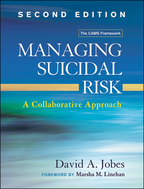 by
by
This extensively revised manual provides a proven therapeutic framework for evaluating suicidal risk and developing and implementing a suicide-specific treatment plan that is respectful, empathic, and empowering. In addition to their clinical utility, the procedures used for assessment, treatment, and progress monitoring within CAMS can help reduce the risk of malpractice liability.
Full Description:
The Collaborative Assessment and Management of Suicidality (CAMS) approach has garnered a strong evidence base and has been implemented by thousands of therapists from a range of orientations in diverse clinical settings. This extensively revised manual provides a proven therapeutic framework for evaluating suicidal risk and developing and implementing a suicide-specific treatment plan that is respectful, empathic, and empowering. In addition to their clinical utility, the procedures used for assessment, treatment, and progress monitoring within CAMS can help reduce the risk of malpractice liability. In a large-size format for easy photocopying, the book includes all needed reproducible tools for implementing CAMS, including the Suicide Status Form-4. Purchasers also get access to a Web page where they can download and print the reproducible materials. For CAMS training opportunities with David A. Jobes, visit www.cams-care.com.
New to This Edition
-
Incorporates a decade's worth of extensive clinical research.
- Fully revised with a greater focus on CAMS as a framework for clinical intervention—not just assessment.
- In-depth case example followed throughout the book.
- Describes innovations to the approach, such as how to target and treat patient-defined "suicidal drivers."
- Additional reproducibles (CAMS Therapeutic Worksheet and CAMS Rating Scale), plus a new version of the Suicide Status Form.
270 Pages Size: 8" x 10�"
- 1. Collaborative Assessment and Management of Suicidality: A Suicide-Specific Intervention within Contemporary Health Care
-
2. The SSF and the Evolution of CAMS
-
3. Systems of Clinical Care and Optimizing the Use of CAMS
-
4. CAMS Risk Assessment: The Collaborative Use of the SSF
-
5. CAMS Treatment Planning: Coauthoring a Suicide-Specific Treatment Plan
-
6. CAMS Interim Sessions: Tracking Suicide Risk Assessments and Treatment Plan Updates
-
7. CAMS Clinical Outcomes and Disposition: Lessons in Living and Postsuicidal Life
-
8. CAMS as a Means of Decreasing Malpractice Liability
-
9. CAMS Adaptations and Future Developments
-
Epilogue
-
Appendix A. CAMS Suicide Status Form–4 (SSF-4): Initial Session, Tracking/Update Interim Session, Outcome/Disposition Final Session
-
Appendix B. Coding Manual for the SSF Core Assessment Scales: Qualitative Assessment
-
Appendix C. Coding Manual for SSF Reasons for Living versus Reasons for Dying
-
Appendix D. Coding Manual for the SSF One-Thing Response
-
Appendix E. CAMS Therapeutic Worksheet: Understanding Your Suicidality
-
Appendix F. CAMS Rating Scale (CRS.3)
-
Appendix G. Frequently Asked Questions about CAMS
-
Appendix H. Complete CAMS Case Example of Bill
|